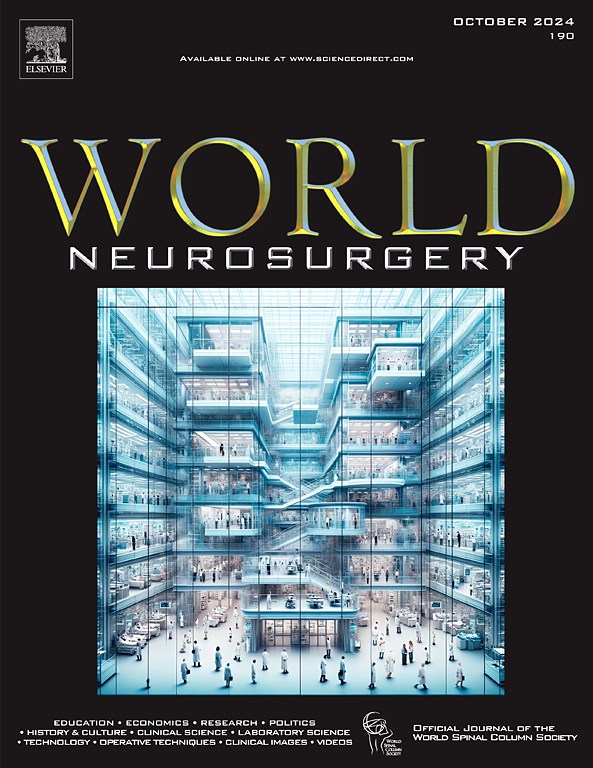微创经椎间孔腰椎椎体间融合术中的可扩展椎间融合器:与来自单一机构、单一外科医生的静态椎间融合器的比较数据。
IF 2.1
4区 医学
Q3 CLINICAL NEUROLOGY
引用次数: 0
摘要
背景:微创经椎间孔腰椎椎体间融合术(MIS-TLIF)被广泛应用于腰椎退行性疾病的治疗。可膨胀保持架现在越来越多地用于MIS-TLIF,以促进狭窄空间内阀瓣高度的恢复。尽管理论上有优势,但与静态笼相比,可膨胀笼的临床和放射学结果仍存在争议。方法:本回顾性研究分析了151例接受单节段腰椎miss - tlif手术的患者,该手术由同一位外科医生在同一机构进行,随访时间超过1年。2022年5月至2023年3月,仅使用静态笼(n=76), 2023年4月至2024年3月,仅使用膨胀笼(n=75)。主要结果是椎间盘高度和前凸角度。结果:与静态笼组相比,可伸缩笼组在术后两期(10.3±1.2 mm vs. 9.5±1.5 mm, p = 0.003)和1年随访(9.6±1.4 mm vs. 9.0±1.6 mm, p = 0.028)均表现出更大的术后椎间盘高度恢复。两组间前凸角度、融合率及临床结果均无显著差异。各种并发症也具有可比性,除了笼子下沉bbb30 mm的发生率,膨胀笼组更高(14.7% vs. 3.9%, p = 0.047)结论:与静态笼子相比,mistlif中的膨胀笼具有更好的椎间盘高度恢复,尽管相对较高的下沉率,但在1年的随访期间保持了固定。在前凸角恢复、临床结果或融合率方面没有观察到显著差异。本文章由计算机程序翻译,如有差异,请以英文原文为准。

Expandable Cage in Minimally Invasive Transforaminal Lumbar Interbody Fusion: Comparative Data with Static Cage from a Single Institution and a Single Surgeon
Background
Minimally invasive surgery–transforaminal lumbar interbody fusion (MIS-TLIF) is widely adopted for the treatment of lumbar degenerative disease. Expandable cages are now increasingly used in MIS-TLIF to facilitate disc height restoration in narrow spaces. Despite theoretical advantages, the clinical and radiologic outcomes of expandable cage compared to static cage remain controversial.
Methods
This retrospective study analyzed 151 patients who underwent single-level lumbar MIS-TLIF performed by a single surgeon at a single institution, with more than 1-year follow-up. Static cages were exclusively used from May 2022 to March 2023 (n = 76), and expandable cages from April 2023 to March 2024 (n = 75). The primary outcomes were radiological disc height and lordotic angles.
Results
The expandable cage group demonstrated significantly greater postoperative disc height restoration compared to the static cage group at both immediate postoperative periods (10.3 ± 1.2 mm vs. 9.5 ± 1.5 mm, P = 0.003) and at 1-year follow-ups (9.6 ± 1.4 mm vs. 9.0 ± 1.6 mm, P = 0.028). There were no significant differences between the groups in lordotic angles, fusion rates, and clinical outcomes. Various complications were also comparable, other than the incidence of cage subsidence > 3 mm, which was higher in the expandable cage group (14.7% vs. 3.9%, P = 0.047).
Conclusions
Expandable cages in MIS-TLIF demonstrated superior disc height restoration compared to static cages, which were maintained throughout a 1-year follow-up period despite the relatively higher subsidence rate. No significant differences were observed in terms of lordotic angle restoration, clinical outcomes, or fusion rates.
求助全文
通过发布文献求助,成功后即可免费获取论文全文。
去求助
来源期刊

World neurosurgery
CLINICAL NEUROLOGY-SURGERY
CiteScore
3.90
自引率
15.00%
发文量
1765
审稿时长
47 days
期刊介绍:
World Neurosurgery has an open access mirror journal World Neurosurgery: X, sharing the same aims and scope, editorial team, submission system and rigorous peer review.
The journal''s mission is to:
-To provide a first-class international forum and a 2-way conduit for dialogue that is relevant to neurosurgeons and providers who care for neurosurgery patients. The categories of the exchanged information include clinical and basic science, as well as global information that provide social, political, educational, economic, cultural or societal insights and knowledge that are of significance and relevance to worldwide neurosurgery patient care.
-To act as a primary intellectual catalyst for the stimulation of creativity, the creation of new knowledge, and the enhancement of quality neurosurgical care worldwide.
-To provide a forum for communication that enriches the lives of all neurosurgeons and their colleagues; and, in so doing, enriches the lives of their patients.
Topics to be addressed in World Neurosurgery include: EDUCATION, ECONOMICS, RESEARCH, POLITICS, HISTORY, CULTURE, CLINICAL SCIENCE, LABORATORY SCIENCE, TECHNOLOGY, OPERATIVE TECHNIQUES, CLINICAL IMAGES, VIDEOS
 求助内容:
求助内容: 应助结果提醒方式:
应助结果提醒方式:


